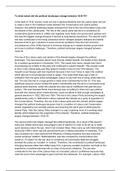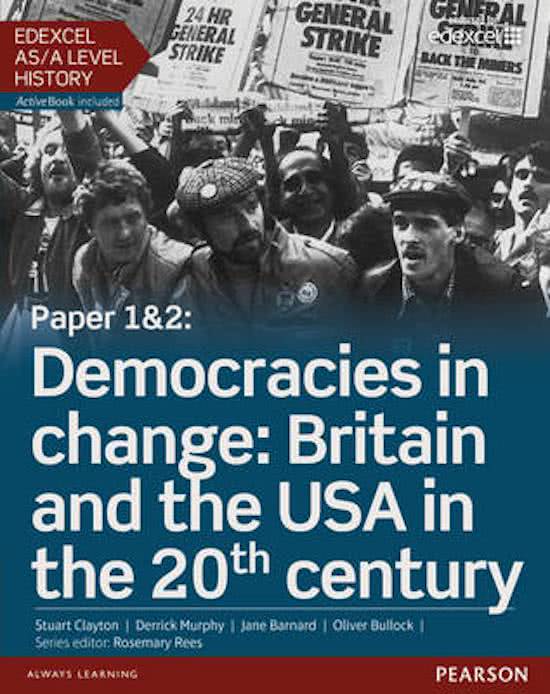To what extent did the political landscape change between 1918-79?
At the start of 1918, women could not vote in general elections and the Labour party had yet
to make a dent in the traditional tussle between the Conservative and Liberal parties.
However, the political landscape largely changed from this to the rise of the labour party and
the decline of the Liberal party. The rise of the Labour party had led to a consensus for
conservative governments to collide and negotiate more freely over government policies and
this was the biggest change because it had led to long-lasting importance. The second world
war also contributed to this rising consensus which changed people's attitudes and beliefs
because it led to gov.t solutions to solve economic problems.Thus the hard economic
circumstances of the 1930s had led to immense change as it created another government
and rose to political challenges. Therefore, political landscape largely changed between
1918-79.
The rise of the Labour party and decline of the liberals largely changed the political
landscape. This was because David Lloyd George ousted Asquith, the leader of the Liberals,
for a coalition government in December 1916. This meant that many Liberals saw David
Lloyd George as a traitor to the party and continued to support Asquith. This caused a split
to form in the Liberal party and they failed to reunite in time for the 1918 election. The
Asquith-Lloyd George split was important because it led most Tories to reject the coalition
which also led to Lloyd-George forced to resign. This meant that there was a lack of
unification from the party which advantaged Labour to rise from this in being united after the
war. The war also led to a huge growth in trade union membership for the LP. This was
significant because unions funded the party’s membership and this led to a successful local
political party machine, unlike the Liberals who also had an ineffective first past the post
system. This was because David Lloyd George was not willing to share his huge political
fund with the Liberals which meant that they could not afford to field enough candidates at
general elections in 1922,1923 and 1924. This led to the Labour Party becoming the largest
parliamentary party in 1929 where Labour replaced the Liberals as a party of opposition to
the Conservatives. Therefore, the rise of the Labour party and the Liberals decline largely
changed the political landscape because it led to a coalition of Labour and Conservative
parties negotiating over socialist policies and acquiring the same goal of destroying the
Liberal Party. Also the Labour Party changed in a way of gaining more of a working-class
identity which helped win the supporters of the Liberals. Therefore, political landscape
largely changed between 1918-79.
The second world war largely changed the political landscape. As a result of the second
world war, British democracy encouraged a war of cabinet of 5 men to be set up to make
quick decisions about the war, which had included Atlee. Atlee came up with Nationalisation
during the 1950’s which was the government's aim in taking ownership of industries. This
was successful as it had improved the efficiency of failing industries and also improved
worker-employer relations. Nationalization was also accepted by Conservatives who
would’ve, if it wasn’t for the war (due to consensus and successful state-led struggle)
branded the policy as ‘socialist’ or ‘radical.’ Therefore, this contributed to political landscape
changing because Atlee had shifted away from a genuine socialist revolution and built on the
experience of wartime planning with an array of economic initiatives. The war also
contributed to the rise of the Labour Party as it boosted Labour’s confidence because they
used the war to their advantage to gain trust from the electorate. For example, Labour 1945
, manifesto of “Let us face the future” was implemented in the Beveridge Report of 1945,
which was also influenced by the war. This was significant because it made state-led
solutions to difficult problems seem like a realistic prospect and so many would be
influenced by this report. (650,000) Therefore, indicated that individuals started to believe
more in the state which meant that their attitudes and behaviour changed into more of a
positive note to trust in the governments and political elections. Labour’s slogan also meant
that they were far more in tune with the demands and expectations of the British public after
6 years of suffering and sacrifice from the war. Additionally, the war became the foundation
for the “post-war consensus” which meant that governments could agree on a range of
important policies between the rival parties. Therefore, the second world war largely
changed the political landscape between 1918-79 because it shaped Britain's politics in a
more profound sense of generation.
Economic circumstances also largely led to the change of the political landscape. In October
1929, the Wall Street Stock Exchange in New York collapsed leading to a global decline in
trade and production. This led to the Conservatives choosing to support Ramsay Macdonald
in the formation of a National government in 1931. The widespread support of a new
government was demonstrated by the British public overwhelmingly backed calls for national
unity in the face of economic crisis and voted for the NG in huge numbers. This meant that
Conservatives and Labour ministers were brought together and also led to the state of
collectivism. This changed the political landscape because it meant that individuals gave up
the right to work with the state for a common purpose. Additionally, the Keynesianism theory
suggested the governments should borrow in times of recession to spend and stimulate
growth in the economy. This meant that Conservatives were looking more at free-market
solutions to problems such as inflation and unemployment, demonstrating a change in their
party. The theory also demonstrated a change of direction in the classical view that
governments should aim to balance the books and not interfere too much in the economy.
Therefore, Conservatives were accepting Labor's post-war reforms to help manage the
economy. Also, many working-class men during the strikes, began to look up to the Labour
party to deliver political solutions in parliament rather than direct action. Therefore, this
improved union's relations with the government in confining with them in times of economic
difficulties. Overall, economic circumstances largely changed the political landscape.
How far do you agree that the landslide victory of the Labour party on the 1945
general election was only possible because of Britain’s experience in the second
world war?
Successive Labour and conservative governments attempted to manage the economy
between 1945-1979 with varied success. However, the second world war largely led to the
landslide victory of the Labour party electorally in the rise of consensus which promoted
agreement between government policies. The war also helped establish the Beveridge
Report in 1942. This provided welfare provision and free healthcare access to the British
public. Nonetheless, Conservative’s defeat and failure to build ‘a home fit for heroes’ also
contributed to Labour’s success. Other criteria, including the governance of Clement Atlee in
1945 in which he was far more in tune with the demands and expectations of the British
people. Although, it is very clear that the landslide victory of the Labour party in 1945 largely
came down to Britain's experience in the second world war.





